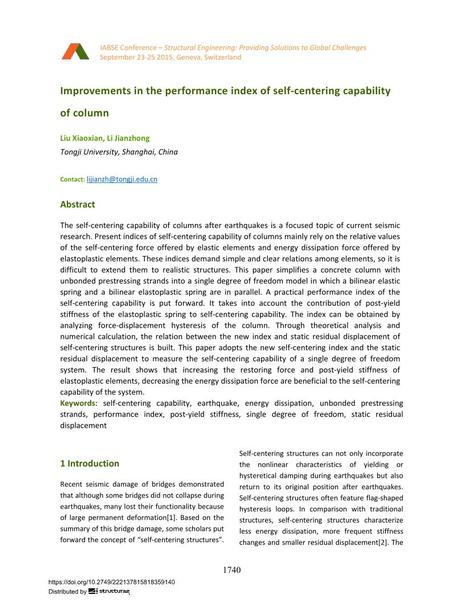Improvements in the performance index of self-centering capability of column

|
|
|||||||||||
Détails bibliographiques
| Auteur(s): |
Xiaoxian Liu
(Tongji University, Shanghai, China)
Jianzhong Li (Tongji University, Shanghai, China) |
||||
|---|---|---|---|---|---|
| Médium: | papier de conférence | ||||
| Langue(s): | anglais | ||||
| Conférence: | IABSE Conference: Structural Engineering: Providing Solutions to Global Challenges, Geneva, Switzerland, September 2015 | ||||
| Publié dans: | IABSE Conference Geneva 2015 | ||||
|
|||||
| Page(s): | 1740-1746 | ||||
| Nombre total de pages (du PDF): | 7 | ||||
| Année: | 2015 | ||||
| DOI: | 10.2749/222137815818359140 | ||||
| Abstrait: |
The self-centering capability of columns after earthquakes is a focused topic of current seismic research. Present indices of self-centering capability of columns mainly rely on the relative values of the self-centering force offered by elastic elements and energy dissipation force offered by elastoplastic elements. These indices demand simple and clear relations among elements, so it is difficult to extend them to realistic structures. This paper simplifies a concrete column with unbonded prestressing strands into a single degree of freedom model in which a bilinear elastic spring and a bilinear elastoplastic spring are in parallel. A practical performance index of the self-centering capability is put forward. It takes into account the contribution of post-yield stiffness of the elastoplastic spring to self-centering capability. The index can be obtained by analyzing force-displacement hysteresis of the column. Through theoretical analysis and numerical calculation, the relation between the new index and static residual displacement of self-centering structures is built. This paper adopts the new self-centering index and the static residual displacement to measure the self-centering capability of a single degree of freedom system. The result shows that increasing the restoring force and post-yield stiffness of elastoplastic elements, decreasing the energy dissipation force are beneficial to the self-centering capability of the system. |
||||
| Mots-clé: |
tremblement de terre
|
||||
